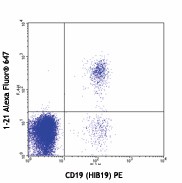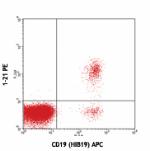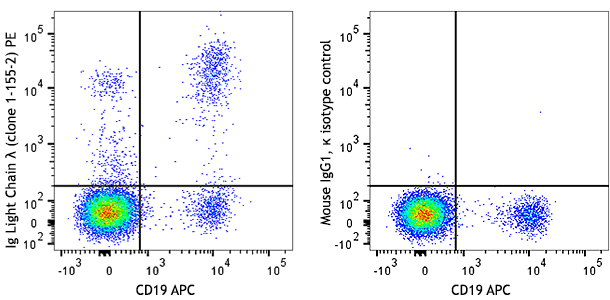- Clone
- 1-21 (See other available formats)
- Regulatory Status
- RUO
- Other Names
- T-cell leukemia/lymphoma protein 1A, Protein p14 TCL1, Oncogene TCL1, TCL-1
- Isotype
- Mouse IgG2b, κ
- Ave. Rating
- Submit a Review
- Product Citations
- 1 publications

| Cat # | Size | Price | Quantity Check Availability | Save | ||
|---|---|---|---|---|---|---|
| 330508 | 100 tests | 247€ | ||||
TCL1, also known as T-cell leukemia/lymphoma protein 1A, protein p14 TCL1 and oncogene TCL-1, is a 14kD beta-barrel protein that was originally identified on the basis of its association with T-cell prolymphocytic leukemia (T-PLL). Activated by the T-cell receptor enhancer through inv(14)(q11;q32.1) or t(14;14)(q11;q32.1), TCL1 is normally expressed in immature cortical thymocytes, activated peripheral T-cells, pro-B cells, and naive mantle zone B cells of peripheral lymphoid tissues, but not in post-germinal center (GC) memory B cells and plasma cells. Akt and TCL1 interact via Akt’s pleckstrin homology domain to form hetero-oligomers at the leaflet of the inner plasma membrane stimulating the protein kinase C-mitogen activated protein kinase-extracellular signal-related kinase (PKC-MAPK-ERK) signal transduction pathway. TCL1 also inhibits activation-induced cell death in T-cells by blocking PKCθ. In addition to T-PLL dysregulation is implicated in such B-cell neoplasias as lymphoblastic lymphoma, chronic lymphocytic leukemia (CLL) and Burkitt lymphoma.
Product DetailsProduct Details
- Verified Reactivity
- Human
- Antibody Type
- Monoclonal
- Host Species
- Mouse
- Immunogen
- outer α-loop region of TCL1 peptide
- Formulation
- Phosphate-buffered solution, pH 7.2, containing 0.09% sodium azide and BSA (origin USA)
- Preparation
- The antibody was purified by affinity chromatography and conjugated with Alexa Fluor® 647 under optimal conditions.
- Concentration
- Lot-specific (to obtain lot-specific concentration and expiration, please enter the lot number in our Certificate of Analysis online tool.)
- Storage & Handling
- The antibody solution should be stored undiluted between 2°C and 8°C, and protected from prolonged exposure to light. Do not freeze.
- Application
-
ICFC - Quality tested
- Recommended Usage
-
Each lot of this antibody is quality control tested by intracellular immunofluorescent staining with flow cytometric analysis. For flow cytometric staining, the suggested use of this reagent is 5 µl per million cells in 100 µl staining volume or 5 µl per 100 µl of whole blood.
* Alexa Fluor® 647 has a maximum emission of 668 nm when it is excited at 633nm / 635nm.
Alexa Fluor® and Pacific Blue™ are trademarks of Life Technologies Corporation.
View full statement regarding label licenses - Excitation Laser
-
Red Laser (633 nm)
- Application Notes
-
Additional reported applications include: immunoprecipitation, western blot, immunohistochemical staining of frozen or formalin-fixed, paraffin embedded tissue sections.
- Application References
-
- Herling M, et al. 2008. Blood 111:328
- Herling M, et al. 2007. Am. J. Surg. Pathol. 31:1123
- Product Citations
-
- RRID
-
AB_2204405 (BioLegend Cat. No. 330508)
Antigen Details
- Structure
- Beta barrel protein, 14kD
- Distribution
- Cytoplasm
- Function
- Enhances Akt mediated cell survival, stabilizes mitochondrial membrane potential
- Interaction
- Akt1, Akt2, Akt3, caco2
- Biology Area
- Cell Biology, Immunology
- Molecular Family
- CD Molecules
- Antigen References
-
1. Narducci MG et al. 2000. Cancer Research 60:2095.
2. Teitell MA et al. 2005 Nat. Rev. Cancer 5:640
3. Laine J et al.2000. Molecular Cell 6:395
4. Virgilio L et al. 1994. Proc. Natl. Acad. Sci. 91:12530
5. Masayuk N et al. 2007 FASEB J. 21:2273
6. Despouy G et al. 2007 Blood 110:4406
7. Rhine S et al. 2006 Blood 108:1991 - Gene ID
- 8115 View all products for this Gene ID
- UniProt
- View information about TCL1 on UniProt.org
Related FAQs
Other Formats
View All TCL1 Reagents Request Custom Conjugation| Description | Clone | Applications |
|---|---|---|
| Alexa Fluor® 647 anti-human TCL1 | 1-21 | ICFC |
| PE anti-human TCL1 | 1-21 | ICFC |
Customers Also Purchased

Compare Data Across All Formats
This data display is provided for general comparisons between formats.
Your actual data may vary due to variations in samples, target cells, instruments and their settings, staining conditions, and other factors.
If you need assistance with selecting the best format contact our expert technical support team.
-
Alexa Fluor® 647 anti-human TCL1

Human peripheral blood lymphocytes stained with anti-CD19 (H... -
PE anti-human TCL1

Human peripheral blood lymphocytes stained with anti-CD19 (H...


 Login / Register
Login / Register 



















Follow Us